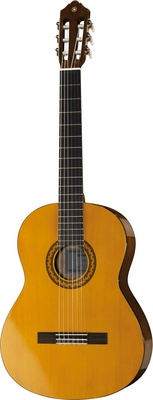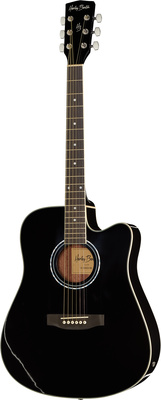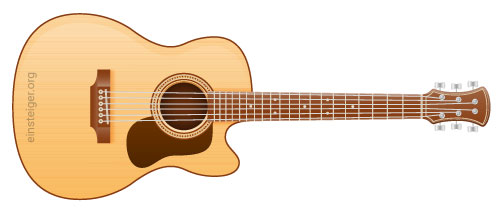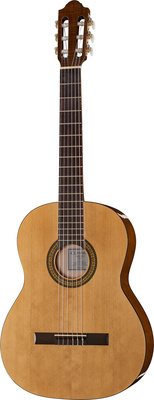Beginner Guitars - The best sets for beginners

Getting started!

Guitars are ideal for teaching children more about music and notes in a playful way. A guitar is a multifaceted instrument that can become a lifelong companion. But which guitar is best for beginners? Basically, there are two types of acoustic guitars, depending on the string material: Classical guitars and Western guitars. In addition, guitars can be classified into several sub-categories based on their shape and size.
Start for adults
Adults are always spoilt for choice. Is it western or concert guitar? If you don’t explicitly want to play classical and quiet music, you should start with a Western guitar. Although the pain and frustration factor is higher at the beginning, the instrument is more versatile. And if you have learned to play on a Western guitar, you shouldn’t have any problems on a concert guitar. On the other hand the change is more difficult.
Start for kids
Children, on the other hand, are recommended to start with a concert guitar. Its nylon strings are not as hard and strong as the steel strings of a Western guitar. In the beginning, injuries and pain can occur if the playing technique is not yet so clean. This can quickly destroy motivation, especially with children. Ideally, however, you will have the opportunity to test both variants in advance and select the right model for your needs.
The setup and components of a guitar at a glance
The functions of the individual components at a glance
The acoustic guitar consists of three main elements: Body, neck and headstock. The body acts as a resonator and transforms the string vibrations into tones during playing. But what about the other components of the guitar? We have summarized the individual elements and their functions in our overview table for you.
| Component | Function |
|---|---|
| Body | The body serves as a resonator and consists of three parts: Soundboard, bottom and ribs. |
| Tuning pegs | Used for mounting and tuning guitar strings. |
| Fretboard | Here the strings are grasped. Frets on the fingerboard make playing easier. |
| Saddle | Connects fretboard to head and leads the strings straight over the neck to the tuning mechanism. |
| Bridge | Located on the soundboard, it fixes the ends of the strings and transmits their vibration to the resonator during playing. |
| Strings | There are six strings of different thickness: E - A - d - g - h - e' (standard tuning). The vibration of the strings produces the sound in the resonating body during playing. |
Guitar types: Western and Classical Guitar
Classical Guitar
Classical guitars are characterized by soft nylon strings, which makes them sound rather warm and dull. In addition, the fingerboard is wider because the strings are stronger than on a Western guitar. The concert guitar is often recommended for beginners because the soft strings are less painful for beginners. Adults, on the other hand, are more likely to prefer a Western guitar.
- Soft nylon strings
- Warm and dull sound
- Suitable for beginners

Western Guitar
Western guitars are equipped with steel strings. These are tighter than on the concert guitar and it takes a little more power to play them. But you get a brighter, clearer sound. Their resonance body is also larger and the fingerboard narrower, as the steel strings take up less space. The Western guitar is therefore also suitable for small hands. Due to the thinner strings, playing with thicker fingers can be a problem.
- Hard steel strings
- Brighter sound and deeper basses

The different guitar shapes and their sound
Western- or Classical Guitars
In addition to the question of whether western or concert guitar, the question of shape and construction also plays a role. Basically, one can say that the larger the body, the louder and more powerful the sound of a guitar is. The most popular and widespread form nowadays is the dreadnought form. It is named after a number of British battleships, the largest in the world at the time. They are called the all-rounders and are characterized by deep bass and louder sounds.
- Dreadnought form as a popular all-rounder

Grand Auditorium and Grand Concert
Somewhat smaller are the more classic Grand Auditorium and Grand Concert shapes. The filigree Grand Auditorium is often used for finger picking. For some time now, guitar builders have also been offering a jumbo shape. It resembles a Grand Auditorium, but has an even larger resonating body than the Dreadnought. As a rule of thumb, guitars gain in volume and depth with their size, whilst their playing comfort suffers.
- Often used for finger picking

Preiswerte Konzert-, Western- und Grand Auditorium Gitarren
- Harley Benton HBD120CEBK Western Guitar
- Spruce soundboard
- Mahogany body
- Mahogany neck
- Roseacer fretboard
check offerThomann Classic 4/4 Classical Guitar- Tinted spruce soundboard
- Bottom & Frames: Beech
- Neck: maple
- Fretboard: Beech
check offerBaton Rouge AR11C/ACE Grand Auditorium- Soundboard: Cedar
- Bottom & Frames: Mahogany
- Neck: Mahogany
- Fretboard & Bridge: Ovangkol
check offerBaton Rouge AR11C/ACE-W Grand Auditorium- Soundboard: Cedar
- Bottom & Frames: Mahogany
- Neck: Mahogany
- Fretboard & Bridge: Ovangkol
check offerChoosing the right guitar size
Guitars are available in different sizes depending on the age and height of the guitarist. Especially for children there is a variety of sizes to choose from, whilst adults usually use a 4/4 guitar. In our table below we have summarized which guitar size is best suited for your age and body size.
Guitar size 1/8 1/4 1/2 3/4 7/8 4/4 Age 3-5 years 4-7 years 6-9 years 8-11 years 11-13 years <13 years Body size >43" 43"-49" 45"-53" 51"-61" 57"-63" <63" Guitar length 74 cm 78 cm 83 cm 90 cm 95 cm 98 cm Scale 40-44 cm 47-49 cm 53-55 cm 58-62 cm 62-63 cm 63-65 cm Classical guitars in the most popular sizes
- Startone 1/4 Guitar
- Body: lime tree
- Neck: Nato
- Fretboard: maple
check offerThomann 1/2 Guitar- Body: beech, spruce
- neck: maple
- Fretboard: beech
check offerStartone 3/4 Guitar- Body: lime tree
- Neck: Nato
- Fretboard: maple
check offerYamaha 4/4 Guitar- Body: spruce, meranti
- Neck: Nato
- Fretboard: Rosewood
check offerThe right beginner guitar for your child
There are many guitars on the market that are specially designed for children. But not all of them are real instruments. Many of them are toys rather than instruments. Such toy instruments are cheaply produced, cannot be tuned and leave a lot to be desired in terms of sound.
But there are also high-quality acoustic guitars, which are adapted to children’s size. They are available in different sizes. The individual size can be determined by a rule of thumb, which calculates the optimal size ratio to a standard guitar. For orientation you can see in our size chart which guitar size is best suited to your age and body size.
What to consider when buying a children's guitar
In general, it is up to you and your child to decide whether you prefer a Western or a concert guitar. For children, however, it is recommended to choose a classical guitar.
The steel strings of a Western guitar require more power when playing and make practicing more complex. In addition, the strings are harder, which can lead to minor injuries and pain, especially for beginners. This can quickly reduce the motivation to learn.
At the end of this section we show you good guitar sets for beginners.
- Classical guitars are ideal for children
Affordable children's guitars for a cheap start
- Startone 1/4 Guitar
- Nylon Strings
- Body: lime tree
- Neck: Nato
- Maple fretboard
check offerStartone 1/2 Guitar- Nylon Strings
- Body: lime tree
- Neck: Nato
- Maple fretboard
check offerStartone 3/4 Guitar- Nylon Strings
- Body: lime tree
- Neck: Nato
- Maple fretboard
check offerStartone 1/8 Guitar- Nylon Strings
- Body: lime tree
- Neck: Nato
- Maple fretboard
check offerGuitars especially for left-handers
There have always been left-handers who played the guitar. One of the best known is Jimi Hendrix. He simply pulled the strings of his guitar the other way around to play with his dominant hand. But this is not advisable. Because guitars are not necessarily symmetrical, the entire body of sound is designed for the composition. Therefore, winding the strings in reverse order can destroy the sound, so that the guitar is no longer octave clean. It is also possible to damage your guitar.
Some musicians have also simply resigned and train their weak hands or get chords for left-handers. Not uncommon are guitars made especially for left-handers. They are available in all colors and shapes, so that even left-handers, who don’t want to be dependent on having to rethink their playing and reading of the notes, can easily start playing the guitar.
check offer![Thomann Classic 4/4 Guitar Lefthand Foto]()
Important features of guitars in comparison
 The tone - Soft or rather powerful?
The tone - Soft or rather powerful?Western guitars with their loud and bright sound are universally applicable. They are often used for modern types of music such as pop and rock. In addition, an electric amplifier can be more easily connected to a Western guitar. They are used wherever it is important to generate clean and powerful sounds.
Classical guitars, on the other hand, with their somewhat softer sound, are mainly used for classical music. The choice of wood also has a decisive influence on the tone.
- Classical guitars for classical guitar music
- Western guitars for modern pieces
 The material - Do not underestimate!
The material - Do not underestimate!The choice of wood has a decisive influence on the sound quality, especially on the soundboard of the guitar. It is usually made of cedar wood or spruce. On cheap models, however, the soundboard can also be made of a simple plywood plate.
Also more exotic woods like mahogany, cedar or koa, from which traditional Hawaiian ukuleles are made, are imaginable. All woods differ in their sound types. For the beginner this may still be secondary, professionals however attach much importance to the choice of the wood fitting to their music. But: The more exotic and unusual the woods are, the more money the guitars cost.
- Elasticity and hardness determine the sound
- For beginners the wood is secondary
 The playability
The playabilityMore power is needed to play the steel strings of a Western guitar. In addition, steel strings often cause pain for beginners and can lead to frustration especially in the beginning. A plectrum is therefore mandatory. However, sooner or later most people will want to switch to a Western guitar anyway, as it is more versatile. By the way, it is much easier to switch from an acoustic guitar to a concert guitar than the other way around. We therefore recommend that children start with a concert guitar, while young people and adults can try their hand at a Western guitar.
- Steel strings are harder, stronger and thinner
- Steel strings are mainly played with a plectrum
Changing guitar strings and rewinding them
If you practice a lot as a beginner, you will notice after a few months that the sound of your guitar will wear off with time. This usually means that the old guitar strings have to be removed and new ones mounted. First the pegs of the guitar are turned clockwise to “relax” the old strings. It is best to start with only one string and change the strings gradually to protect the wood. Now remove one loose end of the string from the mechanism and the lashed or pinned end from the bridge. So far so simple. Tensioning a new string is a bit more complicated, especially for beginners. The video shows you exactly how this works.
What you need to change the strings
- Harley Benton String Set Classical Guitar
- Heriba String winder
- Elixir String Set Western Guitar
Guitar tuning with and without electric tuner
Tuning the guitar without a tuner
The tuning of the guitar even without the help of a tuner is part of the basic skills of a musician. The key to this is the tuning mechanism at the head of the guitar. First you start with a string, preferably the E-string, and play it. If you notice that the played tone is too low, turn the corresponding tuning mechanism counterclockwise higher until the string reproduces the correct sound. If the tone is too high, turn the tuning mechanism clockwise. Continue this way until all strings are tuned. The difficulty: Only those who have a good musical ear and some experience or corresponding sound examples for comparison, know how the tone of each string must sound correctly. Beginners are therefore better off using a special tuner.
Tuning the guitar with a tuner
If you learn to play the guitar, you should know how to tune it without the help of a guitar teacher. A practical aid for particularly accurate tuning is a digital tuner. Especially practical are clip tuners, which can be attached directly to the guitar and make tuning even easier. Tuners usually measure the played tone by vibration. Depending on the instrument, a display or small lights indicate whether the played string is set too high or too low. This means that you do not have to rely on your own hearing to tune the instrument, and you benefit from a very accurate tuning result.
Practical tools for tuning your guitar
- Thomann Clip-Tuner
- Graph Tech Guitar Pegs
- Thomann Tuner
Which types of wood are the best?
![Guitar wood]()
The right wood for the optimal sound
Similar to violin making, guitar manufacturers prefer to use slow-grown wood with narrow annual rings. This so-called tonewood is first stored for several years before processing and then air-dried to generate optimal vibration characteristics. Each type of wood throws back the vibrations in the sound body in a different way, which is why the material used for the guitar body is decisive for the later timbre of the instrument. Which type of wood you prefer depends more on your personal taste than on qualitative differences. Nevertheless, there are some popular types of wood that are often used because of their good and special sound characteristics.
Exotic woods and local classics
Mahogany, for example, is not only inexpensive, but also very versatile and produces a warm and balanced sound. Rosewood is available in different types such as Rio Rosewood or Cocobolo and is often used in the production of bottoms, bridges, fretboards and sides. The classic maple is also very popular in acoustic guitar making due to its clear sound. Spruce, on the other hand, is often used as a guitar soundboard. But whether standard woods such as maple and spruce or exotic woods such as koa or rosewood: what counts is the timbre, which should ideally suit your own playing and taste. Cheap woods can be the right choice as well as expensive rarities.
How to care for your guitar properly
Regular cleaning with a polishing cloth
As with every article of daily use, various dirt and deposits accumulate on the guitar over the course of time. Especially fretboards and strings that are in constant contact with the body during playing should be cleaned regularly to prevent more serious soiling. A simple lint-free polishing cloth is usually sufficient to dry-wipe the instrument briefly after practicing. For a more thorough cleaning, the sides can also be relaxed and then cleaned with the polishing cloth. Special cleaning and care products from specialized dealers, on the other hand, clean the strings particularly intensively and can also contribute to a longer durability thanks to corrosion protection. But be careful: if you have coated guitar strings, pay attention to the care instructions on the packaging to prevent damage.
check offer![Thomann Polishing cloth Foto]()
Intensive wood care with Lemon Oil
In addition to regular cleaning, the care of the guitar wood is also important to ensure a long lifespan and sound duration. Special guitar polishes – for example for varnished fingerboards – and care oils from specialist dealers are recommended. For fretboard care, a so-called “Lemon Oil” is usually used, which preserves the wood, cares for it and makes it shiny. When purchasing, however, you should make sure that the chosen care product is also suitable for the particular guitar wood. For application, it is best to use a lint-free cloth and let the oil soak in for half an hour to an hour and then wipe it over.
check offer![Dunlop Lemon Oil Foto]()
Seal surface with Carnauba wax
In addition to Lemon Oil, Carnauba wax is also an absolute must for guitar care. Carnauba seals the wooden surface of fretboard and body and protects them from moisture loss. This also prevents cracks caused by dryness and thus promotes the instrument’s longevity. A further advantage: the wax not only cares for the guitar, it also conceals minor scratches and irregularities and thus helps to maintain the original condition of the guitar in terms of appearance.
check offer![Dunlop Carnauba wax Foto]()
More cleaning and care products for your guitar
- Dunlop String cleaner
- Warwick Beeswax 100ml
- Rockcare Profi Kit
![gitarre-lernen-info]()
How to learn to play guitar
Guitar lessons
Especially those who come into contact with an instrument for the first time should think about professional guitar lessons in the music school or with a private teacher. Especially for children who are not yet able to read notes, it is not advisable to learn the instrument independently. The disadvantage: private lessons are expensive. A 45-minute lesson recommended for beginners can cost about 60 euros. In return, the student is in direct contact with the teacher so that mistakes can be detected and corrected directly.
- Practice-oriented learning
- Direct exchange
- High cost
![Taking guitar lessons]()
Taking guitar lessons Guitar textbooks
If you already know how to read notes and have perhaps already learned another instrument, you can also learn how to play the guitar by studying a guitar textbook on your own. It is important to make sure that the textbook has an enclosed CD or DVD with which you can listen to or view the respective music examples. While the guitar textbook is not bound to a fixed appointment on the one hand – from which especially working people profit – it also requires a high degree of independence. As soon as you have found the right textbook for you, you should work through it regularly and systematically.
- Low cost
- Self-directed learning
- Requires discipline and self-initiative
![Buying a guitar textbook]()
Buying a guitar textbook Videos for guitar beginners
If you don’t want to invest in expensive lessons or a textbook, you can look for suitable courses and help for beginners on platforms like Youtube. The big advantage is that they are free of charge and clearly convey the correct posture and finger grips. Here the practice-oriented learning stands in the foreground. Thanks to the clear explanations, learning with videos is also suitable for children and young people who already have experience reading notes. Of course, there are also paid online courses to learn how to play the guitar. Learning contents, such as notes and instruction videos, are regularly released. If you want to combine theory and practice, these beginner courses are a good choice.
- Free amateur videos
- Practice-oriented learning
- Paid online video courses
Good guitar textbooks for beginners
- Voggenreiter Acoustic Guitar
- Hal Leonard Gibson´s Learn & Master Guitar
- Hal Leonard Guitar Methode Complete Edition
![gitarre-lernen-info-tab]()
![gitarre-lernen-info-mob]()
Guitar for beginners: Checklist for your guitar purchase
- Pre-tuned instrument
If you don’t dare to tune yourself or don’t have a guitar teacher at hand, you should invest in a pre-tuned instrument. Many beginner models of well-known brands are already factory tuned.
- Guitar set instead of single purchase
Although most guitars come with a matching carrying bag, it can be worthwhile to buy a set. Whether tuner, plectrum, footstool or changeable strings – when buying a guitar set you save money compared with buying each component individually.
- Gigbag
Many guitars come with a matching carrying bag. If this is not the case, a suitable model should be purchased as soon as possible to prevent damage to the instrument.
- No no-name products
Especially in the internet many no-name providers lure with cheap guitars for beginners. But be careful, because the quality is often inferior. If you want to be on the safe side, you better invest in instruments from proven manufacturers.
- Guitar size depending on body size
While adults usually get along with a 4/4 guitar, the optimal guitar size can vary depending on your body size. Use our size chart to find the right guitar size for you.
- Classical or Western guitar?
Depending on what you intend to do with the guitar, a different construction may be suitable. For beginners, the classical concert guitar is recommended, which is used especially for classical pieces due to its warm sound. Western guitars, on the other hand, are strung with steel strings and produce a rather bright sound.
- No steel strings for children
Especially for children it is not recommended to start with a Western guitar, because they are strung with steel strings. Beginners who are still inexperienced can suffer unpleasant injuries when playing with steel strings and quickly lose the fun of playing the guitar.
- Material: Soundboard made of cedar or spruce
A solid soundboard made of cedar or spruce is an important quality feature when buying a guitar. Although plywood is also acceptable for beginners, it should be avoided in the long run as it impairs the sound.
Good guitar sets for beginners compared
Klasse Western Classical Classical Classical Product Harley Benton
Blues Guitar Set 2Startone
CG851 4/4 Classical Guitar SetThomann
C-403 NT SetThomann
Classic 4/4 Guitar Blac BundlePicture Best deal![Harley Benton Blues Guitar Set 2 Foto]() Best price
Best price![Startone CG851 4/4 Classical Guitar Set Foto]()
![Thomann C-403 NT Set Foto]()
![Thomann Classic 4/4 Guitar Blac Bundle Foto]()
Wood Mahogany, roseacer Basswood, hardwood Sprue, catalpa, blackwood Spruce, basswood, hardwood Age <12 years <12 years <9 years <12 years Set contents That contains the Guitar-beginner set Guitar Guitar Guitar Guitar Guitar Bag Bag Bag Bag Bag Textbook Textbook Textbook Textbook Textbook CD CD CD CD CD Tuner Tuner Tuner Tuner Tuner Picks Picks Picks Picks Picks Guitar-stand Guitar-stand Guitar-stand Guitar-stand Guitar-stand Offer only 75 €only 64 €only 77 €only 115 €Equipment for acoustic guitars
- Gigbag
- Picks
- Guitar holder
- Guitar stand
- Kapodaster
The most important questions and answers at a glance
What should I pay attention to when buying my guitar?
Instruments are an expensive purchase that needs to be considered carefully. Therefore, look out for well-known manufacturers such as Yamaha, Höfner or Harley Benton, who also offer inexpensive models for beginners. Cheap no-name products, on the other hand, are not recommended, as the workmanship often leaves much to be desired. The material of the guitar also plays an important role when it comes to timbre: pay attention to solid wood such as cedar or spruce. Further tips for your guitar purchase can be found in our buyer´s guide.
Where can and should I buy a guitar?
When buying a guitar, advice and purchase from a local dealer are an obvious option. If you buy your instrument on the internet, you should consult a reputable dealer such as Thomann or Kirstein. Here you not only benefit from a larger selection of well-known brands, but are also immune to mispurchases thanks to the warranty.
Which guitar is best for beginners?
If you are just starting to play the guitar or just want to try it out, a reasonably priced beginner model in the right size is the best choice. Nevertheless, you should also pay attention to features such as wood quality and workmanship in order not to impair the playing feel and sound result. Meanwhile many well-known manufacturers offer a wide range of inexpensive beginner guitars. A small orientation, which models have the best price-performance ratio, can be found in our comparison.
Which guitar is best for my height?
For adults from 1.60 m a 4/4 guitar is usually the best choice. For children and teenagers there are several guitar sizes to choose from. Please refer to our size chart.
Can I tune my guitar myself and if so, how?
Tuning an acoustic guitar is relatively easy, so even beginners will get along with it. It is best to use a so-called tuner. If you play a string, the tuner will show you if the played tone is reproduced correctly. By adjusting the pegs you can now correct the string tone upwards or downwards. Here you can find a little instruction how to tune the guitar with and without a tuner.
When and how often should I exchange the strings of my guitar?
Depending on how often and intensively you play, the guitar strings should be exchanged after a few months or at the latest after three quarters of a year. If you are already a bit more experienced, you usually can tell by the sound whether the strings need to be replaced.
How can I exchange the old strings of my guitar?
Turn the guitar pegs clockwise to relax and remove the worn strings. Placing new strings is a bit more complicated. For this purpose, please refer to our instruction video.
Which wood is the best for an acoustic guitar?
The top of a guitar should at best be made of solid wood such as spruce or cedar. On the other hand, plywood is often used as material for lower quality models.
Are there also guitars for left-handers available?
By now there are numerous guitar models that are made especially for left-handers. Methods à la Jimi Hendrix, on the other hand, who simply pulled the strings of his guitar upside down, are not recommended, because it impairs the octave purity of the guitar and can damage the instrument in the worst case.
Which components does the guitar consist of and how is it constructed?
A classical acoustic guitar consists of three parts: Corpus, neck and head. The corpus gives the guitar its shape and serves as a sound body due to the sound hole. On the top of the corpus there is the so-called bridge to which the lower string ends are attached. On the neck of the guitar there is a collar and a fingerboard. The “saddle” at the upper end of the neck also marks the transition to the guitar head, where the pegs for stringing and tuning the guitar strings are located. Guitars can also be divided into different types such as Western, Concert, Grand Auditorium or Grand Concert guitars, more information here.
How can I clean and care for my guitar?
It is often sufficient to wipe the fingerboard and strings of the guitar regularly with a dry polishing cloth in order to prevent larger soiling. A special guitar polish from a specialist dealer is best suited for wood care. Experiments with conventional care products and oils, on the other hand, should be avoided as wood and varnish could be damaged.
How can I store my guitar?
Since the wood of the guitar reacts to extreme temperature fluctuations, it is best to store it dry at a room temperature of about 21°C. In order to prevent scratches and other damage to the instrument, a gigbag or a suitable guitar case is also recommended.
Scale - what is it?
On stringed instruments such as the guitar, the scale refers to the “free-swinging” length of the guitar strings between saddle and bridge.
Picture sources: © grki , © Photographee.eu , © kontur-vid , © Andy Dean , © Smileus , © Wayhome Studio , © camrocker , © twinsterphoto , © New Africa , © Oleg - Fotolia.comOur Guitar recommendations![Harley Benton Blues Guitar Set 2 Foto]() Harley Benton Blues Guitar Set 2check offer
Harley Benton Blues Guitar Set 2check offer![Startone CG851 4/4 Classical Guitar Set Foto]() Startone CG851 4/4 Classical Guitar Setcheck offerOr have a look at Thomann.de!
Startone CG851 4/4 Classical Guitar Setcheck offerOr have a look at Thomann.de!










































